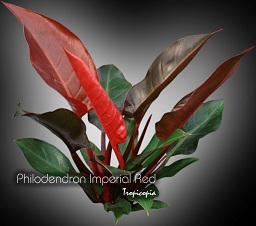Table of contents
Red Philodendron

Latin Name: Philodendron ‘Imperial Red’
Category: Philodendron
Family: Araceae
Origin: Cultivar
Climate: Tropical
Growing Zones: 11-10
Care Instructions
The Red Philodendron (Philodendron ‘Imperial Red’) is a tropical plant that originates from Cultivar. This philodendron plant belongs to the Araceae family and is well-suited for growing in USDA zones 11-10.
Complete Care Guide for Red Philodendron (Philodendron ‘Imperial Red’)
Watering Requirements
The Red Philodendron, known for its striking red foliage, thrives best with a consistent watering schedule. It is essential to allow the top inch of soil to dry out between waterings. Overwatering can lead to root rot, a common issue with this plant. During the growing season (spring and summer), water the plant thoroughly, ensuring that excess water drains out of the pot. In the fall and winter months, reduce watering frequency as the plant enters a dormant phase. Always check the moisture level by sticking your finger into the soil; if it feels dry, it’s time to water. Additionally, using room temperature water can help prevent shock to the roots.
Light Conditions
Red Philodendrons prefer bright, indirect light but can tolerate lower light conditions. However, too much direct sunlight can scorch the leaves, leading to unsightly brown patches. Ideally, place your plant near a window with filtered light or in a well-lit room. If you notice the leaves losing their vibrant color or becoming leggy, it may be a sign that the plant is not receiving enough light. Conversely, if the leaves are curling or browning, consider moving it to a location with less direct sunlight. Regularly rotating the plant can also ensure even growth and exposure to light.
Soil Preferences
The ideal soil for a Red Philodendron is a well-draining potting mix that retains some moisture without becoming soggy. A blend of peat moss, perlite, and orchid bark works well to provide the necessary aeration and drainage. This plant benefits from a slightly acidic to neutral pH level (around 6.0 to 7.0). Fertilization should be done during the growing season with a balanced, water-soluble fertilizer every 4-6 weeks. In the fall and winter, reduce or eliminate fertilization as the plant’s growth slows down. Always ensure that the pot has drainage holes to prevent water accumulation at the bottom.
Pests and Diseases
While the Red Philodendron is relatively resilient, it can be susceptible to common houseplant pests such as spider mites, aphids, and mealybugs. Regularly inspect the undersides of leaves and stems for any signs of infestation. If you notice pests, treat them promptly with insecticidal soap or neem oil, ensuring to cover all affected areas. Additionally, keep an eye out for signs of fungal diseases, which can occur in overly humid conditions or with poor air circulation. Yellowing leaves or a mushy stem can indicate root rot, often caused by overwatering. If this occurs, remove the plant from its pot, trim away any rotten roots, and repot it in fresh, dry soil.
Special Care Tips
To maintain the health and beauty of your Red Philodendron, consider the following special care tips: First, regularly wipe the leaves with a damp cloth to remove dust, which can hinder photosynthesis. This also helps to keep the plant looking vibrant and healthy. Additionally, Red Philodendrons can benefit from occasional pruning to encourage bushier growth and remove any dead or yellowing leaves. If you notice the plant becoming too large for its pot, consider repotting it every couple of years to provide fresh soil and more space for growth. Lastly, be mindful of temperature; Red Philodendrons prefer temperatures between 65°F and 80°F (18°C to 27°C) and should be protected from cold drafts and sudden temperature changes.








